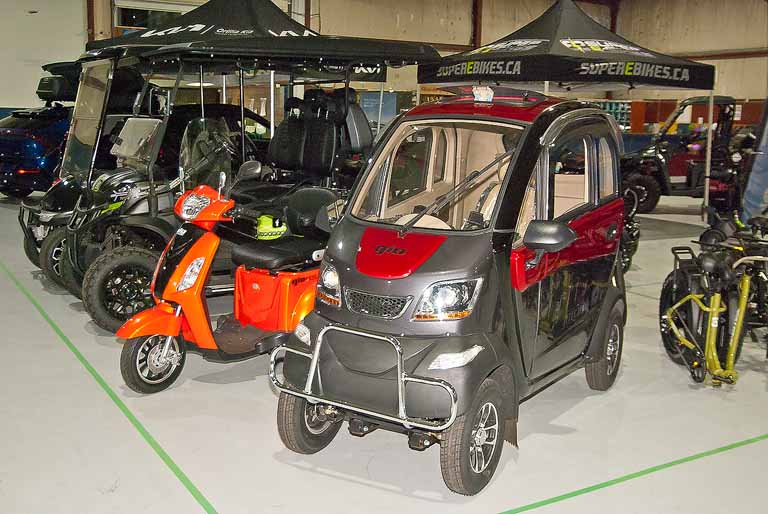Electric Vehicles Showcase Points The Way
Hi: Glad you found us. Can you do us a small favour (and yourself too). Can you please email the link to this story to a few of your friends (enemies too). Facebook took their ball and went home (for now). They were an important service we used to distribute our stories, but not vital. You could also click the yellow button at the bottom of this story and sign up for email alerts when we post news stories (usually only two or three emails a week), and maybe click the other yellow button and get a paid subscription. Thanks.
Editorial By Fred Larsen
The Sustainable Orillia All-Electric Vehicle Weekend on the August 5/6 weekend had close to 550 people turn out to the ODAS Park Roller Skating Place to see the latest in electric vehicles of all types—cars, pick-up trucks, scooters, motorcycles, bikes, a snowmobile, surf boards, an electric boat, tractors, lawn mowers, and leaf blowers. It was a broad display of emerging electric technologies. The show also featured home chargers, adapters for at-home charging, solar panels and storage batteries, and more.
The reaction of most members of the public to the wide array of displays? “Amazing” was a common refrain. One person, after test driving a Tesla, was heard to say, “I want one of these.” People were surprised to see how quickly the technology around electrification is being adopted by a whole range of vehicles and appliances.
These new technologies are emerging as a result of actions being considered, and taken, to reduce the emissions affecting our climate. At long last, governments and private sector businesses are moving toward the electrification of our economy and daily living and the eventual elimination (mostly) of fossil-fuel use. In the process of searching for answers to the climate crisis, we are finding better ways of doing many things, and in the process we are beginning to move toward a healthier, more sustainable way of living and working.
The vision of A Better World To Come is now emerging in the literature. A recent book by journalist, author and environmentalist Chris Turner, How to be a Climate Optimist: Blueprints for a Better World, is an example of the new perspective on how people should consider changes and adaptations needed to limit the rising CO2 in our atmosphere and to address the climate change effects we are experiencing, – particularly in this summer of 2023, the hottest summer on record.
For years, many have pitted the environment against the economy, arguing that we can’t afford the costs of moving away from fossil fuels or that leaving fossil fuels in the ground is a waste of one of Canada’s natural resources. Common responses to the increasing call for climate action were often negative, for example:
- “I’ll have to spend a lot of money on a new EV?”
- “I’ll have to retrofit my whole house?”
- “I have to replace my gas (or oil) furnace?”
- “I’ll have to give up eating meat?”
In the past three or four years it has become clear that the rising costs of continuing our fossil-fuelled way of life and the rebuilding and relocating of people is not sustainable as we watch fires destroy forests and towns, experience severe storms marching through areas leaving devastation behind, learn of drought bringing hardship and loss to farm communities in our prairies and elsewhere, and see the astonishing destruction caused by floods and mudslides worldwide. We should also mention human suffering and loss, the expected increases in insurance (or even the ability to be insured, in some cases), and the ongoing loss of forest resources and their ability to sequester carbon?
Even our oceans are signaling us their ability to foster life and to feed humans across the globe is under serious threat.
And yet, there is reason for optimism. The changes we are being asked to make may lead us to a better future, a better and more satisfying life.
Here are some of these reasons:

1. Electric vehicles not only have fewer emissions, they will lead to quieter, healthier streets and towns. Gas and diesel-powered vehicles not only emit CO2, they also emit methane and nitrous oxide. Particulate matter from diesel engines is a particularly dangerous pollutant. The reality is, while walking is a healthy exercise, walking through streets filled with today’s car traffic and air pollution it creates can expose pedestrians to serious health effects (cancer, heart problems, respiratory disease). As electric vehicles replace current vehicles, our air, especially in towns and cities, will become cleaner and healthier for us all. And they’ll be quieter places, too.
2. Electric vehicles are already demonstrating that maintenance costs drop sharply when one replaces a gas or diesel-powered vehicle with an electric vehicle. Comparisons of lifetime costs show cost-savings for owners of EVs that arise from these low maintenance costs, making driving of these vehicle less costly. Electrical charging is likely to remain substantially cheaper than filling up with gas each week, with gas prices expected to remain high or go even higher.
3. Indoor pollutants can be hazardous, as well. Gas and oil furnaces give off gases that are detectable in the household air. Recent research reveals kitchen gas stoves may be a major source of respiratory problems like asthma in children.
Replacing sources of heating and cooking with electric appliances and heat pumps, electric ovens, and induction stove tops can reduce indoor pollutants, again creating a healthier environment for ourselves and members of our families.
4. Improved housing not only reduces emissions, it makes living in the home more comfortable. Reducing heat losses means fewer drafts, more consistent indoor temperatures, and better ventilation. Changes to the housing envelope, to windows and doors or to insulation will reduce the annual cost of heating your home.
5. The fifteen minute city is an urban-planning concept in which most daily necessities and services, such as work, shopping, education, healthcare, and leisure can be easily reached by a 15-minute walk or bike ride from any point in the city. This approach aims to reduce car dependency, promote healthy and sustainable living, and improve wellbeing and quality of life for city dwellers. While still mostly a concept, the idea can lead to cities like Orillia making changes that will benefit everyone, residents and visitors alike. Urban design that forces people to rely on a car for transportation is a practice that should end.

6. Given the costs associated with owning a car in this day and age, perhaps the future for many people, especially those living in urban environments, is to never own a car. Good transit options – car-sharing, mass transit, taxis, Uber, bicycles, and scooters can reduce the need for a personal vehicle. A longer trip is still possible with a rental vehicle (an EV, of course). The decision not to own a car, whether electric or fossil-fuelled, may be one of the largest cost-saving decisions of all as the climate crisis urges us to consider our options more carefully.
All in all, the choices we make during this transition period may result in a healthier, more comfortable, more economical way of life. And who could possibly object to creating “a better world”?
(Photos by Swartz – SUNonline/Orillia)
Comment




